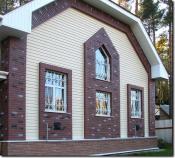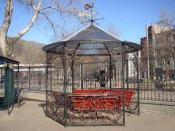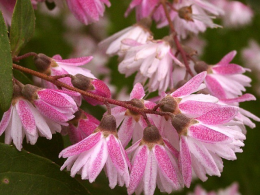Search
Login
Recommended
How to choose, grow, feed and preserve the action bush in winter
Flowering action bushes, especially planted in a row, create an abundantly flowering wall. We will tell you about this magnificent shrub in detail.
Content
- Shrub Overview video
- Rough action
- Amur Deytsiya
- Deytsiya Vilmorena and action graceful
- Large-flowered action
- Purple action
- Action hybrids
- Planting and location methode
- Shrub top dressing
- Shelter for the winter
- Seed propagation
- Propagation by cuttings
- Propagation by layering
Shrub Overview
The genus of the bush of Deytsia, comes from the hydrangea family.
There are about 50 species of shrubs.
In vivo distributed in East Asia, the Himalayas and Mexico.
The blooming action, from afar, resembles a blooming mock-up.
Deytsiya - shrub from 1 to 4 meters tall, mostly deciduous shrubs.
Flowers are smaller in size than those of the mock-up, collected in panicled inflorescences.
The color is mainly white, occasionally pink, odorless.
Abundant flowering of action takes place during three, four weeks, in late spring - early summer.
Breeders have produced garden hybrids of action, including terry hybrids.
Rough action
Rough or star-shaped action is found in the natural conditions of Japan and China.
The height of this graceful shrub reaches 2.5 meters.
The shrub got its name because of the very rough, elongated, ovoid leaves.
The shrub is characterized by late flowering - from mid-July, when flowering, forms elegant white brushes up to 12 cm long.
Breeders brought terry forms.
Rough deytsia is one of the most winter-hardy actions, although in frosty winter it freezes to the level of snow cover, young plants are especially affected.
Amur Deytsiya
Amur or small-flowered action grows in coniferous-deciduous forests of the Far East, China and North Korea.
This is the most winter-hardy and unpretentious shrub of the type of action.
In appearance it resembles a spirea, the bush has a spreading crown and a height of up to two meters.
Blossoms in white, corymbose inflorescences, up to seven centimeters.
Abundant flowering from late May to late June.
Deytsiya Vilmorena and action graceful
Deytsiya Vilmorena, in culture, is a shrub up to two meters high, originally from China.
Blooms in white, collected in corymbose inflorescences, in the month of June.
Deytsia graceful grows in the mountains of Japan.
The culture has variegated, ornamental shrubs, up to one and a half meters high, have a rounded shape.
The shrub has thin arched branches, elongated leaves.
Flowering occurs in early June, white flowers create lush brushes, up to nine centimeters long.
The shrub is fast growing, but it can winter in Russia, it can only in the south of the middle zone, it blooms well in cities.
Large-flowered action
This shrub came from North China and Korea, the height of the shrub is up to two meters, has oval leaves and large white flowers up to three centimeters in diameter.
Flowers are usually solitary, sometimes two to three flowers sit on the end of a branch.
It grows in Russia in the south, in the middle lane in winter they cover it with spruce branches and dry leaves.
Purple action
Purple action hails from Southwest China.
This shrub has a height of up to two meters, thin branches, ovoid leaves with a drawn tip.
The shrub has purple-pink flowers that create loose inflorescences.
Action hybrids
Breeders combining the action of rough and Vilmorena created a hybrid of action magnificent or magnificent.
The result was a shrub up to two and a half meters high, the straight branches of which are covered with white, terry, gathered in lush panicles up to ten centimeters long - the branches bend under the weight of inflorescences.
It blooms in June, is very much appreciated in European gardening.
Deytsia Wilson - a hybrid of deytsiya soft and two-tone.
This shrub is distinguished by a very plentiful flowering.
The action of Lemoine is a hybrid of graceful action and low-flowering action.
This shrub blooms in May, the flowering is plentiful, snow-white flowers have up to two centimeters in diameter - they are collected in panicled inflorescences, up to ten centimeters long.
Landing method and location
The action shrub loves a sunny place that is sheltered from the cold wind.
In the southern regions, in the heat, they like a light midday shadow.
They don’t like acidic soil, but they love nutritious, alkaline soil with good drainage, they don’t like strong moisture, tolerate drought well.
When planting, in the spring, they dig a hole 0.5 meters deep, lay 15-20 cm of sand at the bottom.
The root neck of the action is located at ground level.
The root system has two types of roots: several large roots go to great depths, and thin fibrous roots are located in the upper layers of the soil.
If an adult shrub is replanted, a large root is cut off at a distance of 30 cm from the base, and thin roots must be well preserved.
Shrub top dressing
Shrubs of action like top dressing with liquid manure.
The first feeding occurs in early spring, the second at the beginning of flowering, the third after flowering.
It is better to replace the third top dressing with phosphorus-potassium fertilizer.
If cropping of the action is done, apply complex mineral fertilizer.
If the soil is acidic - in spring add slaked lime under each bush.
Shelter for the winter
The middle strip of Russia requires a light shelter for winter action.
If the shrub is undersized, up to one meter high, young plants are bent to the ground, fastened with wooden pins and covered with a dry leaf 20 cm high, a spruce tree is laid on top, it can be covered with earth or snow.
An adult plant has brittle branches, so they are tightly tied with any breathable material in late autumn, and a dry leaf is stuffed between the branches before tying.
Seed propagation
Sowing with seeds is done in spring, the seeds are laid out on the surface of the rammed earth, the seeds do not fall asleep with the ground, they constantly maintain humidity.
After three weeks, seedlings appear that need to be constantly moistened.
Seedlings of the first year, they surely shelter for the winter, they will bloom in the third year.
Propagation by cuttings
In the second half of June, from young shoots, cuttings of green 4–5 cm long are cut; the cutting must have at least one internode.
The lower slice is always made oblique, under the lower base of the sheet, and the upper slice is made above the upper node.
Green leaves are shortened by half, the cuttings are then planted in a greenhouse to a depth of one centimeter.
Cuttings are constantly sprayed, watered and shaded from the sun.
After two to four weeks, the cuttings take root.
Propagation by layering
If you bend several annual shoots to the ground in autumn or early spring, pin them and cover them with earth - the shoots will give roots.
In the fall or next spring, layering is separated from the mother and planted in a permanent place.





